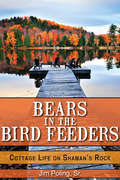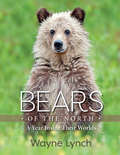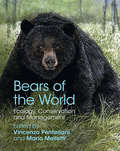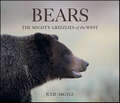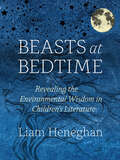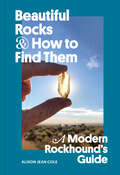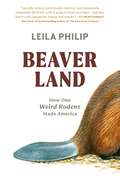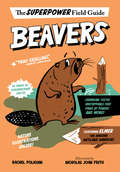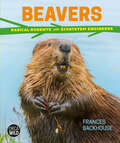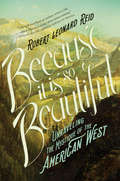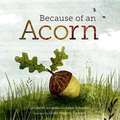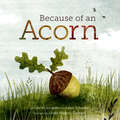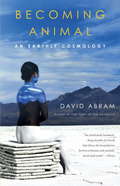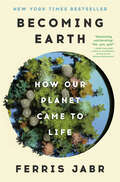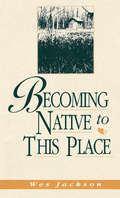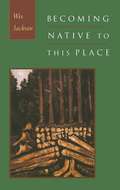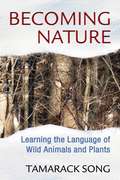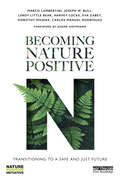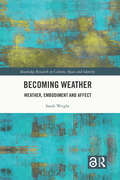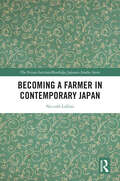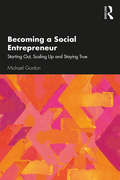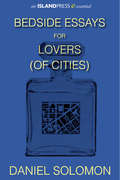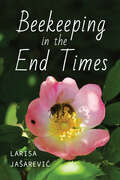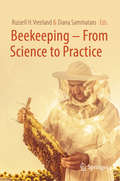- Table View
- List View
Bears in the Bird Feeders: Cottage Life on Shaman’s Rock
by Jim Poling Sr.As well as fun and relaxation, cottage living throughout the seasons is a reminder that all of us, even the most urbanized individual, are part of the natural world. Listen carefully and you will hear cottage country whispering lessons that can make our lives less frenetic, less complicated. The mournful call of the loon, the wind sighing in the trees, the hammering of the pileated woodpecker remind us that we are a part of a more natural world too often lost in our urban societies. Reflections from a still lake and a flickering campfire help us to realize that things might go easier for humankind if more issues were examined in softer, reflective light and without heated debate. People gathered at campfires, soothed by nature’s tranquility, tend to listen and be more thoughtful before they speak. This book will bring you on a journey through four seasons of cottaging and show you that nature has a remarkable power to heal – it just needs the human race to give it a helping hand. Along the way it will introduce you to some tips and tricks for making cottage life more comfortable and enjoyable.
Bears of the North: A Year Inside Their Worlds
by Wayne LynchAn unprecedented visual and scientific journey into the secret world of bears.In Bears of the North, renowned wildlife photographer, naturalist, and bestselling author Wayne Lynch offers us a work of scintillating science and stunning beauty. Following polar bears, brown bears, and American and Asiatic black bears through the seasons, this journey is an insider's view of hibernation's mysteries and the birth of cubs in winter; the mating rituals and voracious appetites of spring; hunting, fishing, and encounters with neighbors during summer; and the feeding frenzy and exuberant play of autumn. Dispelling the stereotypes and untruths—but none of the magic—surrounding these magnificent animals, Lynch comments on the latest scientific discoveries related to the biology, behavior, and ecology of bears. He describes how satellite telemetry has revealed the purpose behind the meanderings of bears and the great distances they sometimes cover on land and in water. He also shows how DNA analysis can teach us about the relatedness of bears within a population, even revealing the identity of a particular cub's father. Taking us out into the wilds of the tundra and forests to share his firsthand observations of the marvelous bears of the Northern Hemisphere, Lynch describes their survival strategies and the threats they face from habitat fragmentation and global climate change. Lynch's fascinating narrative is enhanced by over 150 gorgeous, original color photographs that capture bears in their habitats, including appearances of the elusive moon bear, fierce polar bear battles, and rare images of mothers' intimate moments with their cubs. Informed by Lynch's nearly forty years of experience observing and photographing bears in the wild, and aided by sophisticated digital photo technologies, Bears of the North is an unrivaled collection of enthralling and informative portraits of bears in their natural environments.
Bears of the World: Ecology, Conservation and Management
by Mario Melletti Vincenzo PenterianiBears have fascinated people since ancient times. The relationship between bears and humans dates back thousands of years, during which time we have also competed with bears for shelter and food. In modern times, bears have come under pressure through encroachment on their habitats, climate change, and illegal trade in their body parts, including the Asian bear bile market. The IUCN lists six bears as Vulnerable or Endangered, and even the Least Concern species, such as the brown bear, are at risk of extirpation in certain countries. The poaching and international trade of these most threatened populations are prohibited, but still ongoing. Covering all bear species worldwide, this beautifully illustrated volume brings together the contributions of 200 international bear experts on the ecology, conservation status, and management of the Ursidae family. It reveals the fascinating long history of interactions between humans and bears and the threats affecting these charismatic species.
Bears: The Mighty Grizzlies of the West
by Julie ArgyleThe mighty North American brown bear, most often referred to as the grizzly, is an iconic symbol of power and strength. Mostly found in the Western United States and Canada, the still-endangered bruin has made strides into a tenuous sustainability. The strikingly beautiful photography, and the essay woven through the pages of Bears: The Mighty Grizzlies of the West, showcases this beautiful, smart, and incredible species. Julie Argyle explores their behavior, their family dynamics, and what it means to be a grizzly in the wilderness of the greater Yellowstone area. She includes stories about individual bears: Raspberry and Snow, The Beryl Sow, The Obsidian Sow, Snaggletooth, and 791 (a famous boar), and looks at the issues of increasing conflicts between humans and the grizzlies and what the future holds for them.
Beasts at Bedtime: Revealing the Environmental Wisdom in Children's Literature
by Liam Heneghan“[A] fresh new look at animal tales, often classic, and how they pertain to the present-day and our often fraught relationship to our environment.” —Jeff VanderMeer, author of the Southern Reach TrilogyTalking lions, philosophical bears, very hungry caterpillars, wise spiders, altruistic trees, companionable moles, urbane elephants: this is the magnificent menagerie that delights our children at bedtime. Within the entertaining pages of many children’s books, however, also lie profound teachings about the natural world that can help children develop an educated and engaged appreciation of the dynamic environment they inhabit.In Beasts at Bedtime, scientist (and father) Liam Heneghan examines the environmental underpinnings of children’s stories. From Beatrix Potter to Harry Potter, Heneghan unearths the universal insights into our inextricable relationship with nature that underlie so many classic children’s stories. Some of the largest environmental challenges in coming years—from climate instability, the extinction crisis, freshwater depletion, and deforestation—are likely to become even more severe as this generation of children grows up. Though today’s young readers will bear the brunt of these environmental calamities, they will also be able to contribute to environmental solutions if prepared properly. And all it takes is an attentive eye: Heneghan shows how the nature curriculum is already embedded in bedtime stories, from the earliest board books like The Rainbow Fish to contemporary young adult classics like The Hunger Games.This book enthralls as it engages. Beasts at Bedtime will help parents, teachers, and guardians extend those cozy times curled up together with a good book into a lifetime of caring for our planet.“Beasts at Bedtime is proof that most kidlit has teachable moments embedded in it.” —Toronto Star
Beautiful Rocks and How to Find Them: A Modern Rockhound's Guide
by Alison Jean ColeNew to rockhounding or ready to ramp up your skills? This contemporary guide to rock collecting goes beyond the "where and how" to include info on environmental impact, land stewardship, and building a truly meaningful collection.Do you love rocks and gems? Are you a geology enthusiast? This informative guidebook by professional lapidary artist and outdoor recreation guide Alison Jean Cole shows you that beautiful rocks can be found anywhere. You’ll be expertly guided through the practice of rockhounding (looking for rocks) while learning how to be gentle on the earth.Unlike traditional rock guides, which take readers to well-trodden locations in each state, this book can be used anywhere in the United States or Canada. You'll be guided through the process of becoming an adept rockhound, including:How to read geologic maps and way-findHow to consider the ethics of rock collectingDeveloping your personal tastes in rocks and building a collectionPacked with information and fifty-eight accompanying full-color photos, Beautiful Rocks and How to Find Them is perfect for seasoned collectors and beginner rockhounds alike. It also makes a wonderful gift or self-purchase for nature lovers and rock, mineral, and fossil enthusiasts who love looking for and identifying cool rocks in the wild but could use some expertise and guidance.
Beaverland: How One Weird Rodent Made America
by Leila PhilipAn intimate and revelatory dive into the world of the beaver—the wonderfully weird rodent that has surprisingly shaped American history and may save its ecological future. From award-winning writer Leila Philip, Beaverland is a masterful work of narrative science writing, a book that highlights, though history and contemporary storytelling, how this weird rodent plays an oversized role in American history and its future. She follows fur trappers who lead her through waist high water, fur traders and fur auctioneers, as well as wildlife managers, PETA activists, Native American environmental vigilantes, scientists, engineers, and the colorful group of activists known as beaver believers. Beginning with the early trans-Atlantic trade in North America, Leila Philip traces the beaver&’s profound influence on our nation&’s early economy and feverish western expansion, its first corporations and multi-millionaires. In her pursuit of this weird and wonderful animal, she introduces us to people whose lives are devoted to the beaver, including a Harvard scientist from the Blackfeet Reservation in Montana, who uses drones to create 3-dimensional images of beaver dams; and an environmental restoration consultant in the Chesapeake whose nickname is the &“beaver whisperer&”. What emerges is a poignant personal narrative, a startling portrait of the secretive world of the contemporary fur trade, and an engrossing ecological and historical investigation of these heroic animals who, once trapped to the point of extinction, have returned to the landscape as one of the greatest conservation stories of the 20th century. Beautifully written and impeccably researched, Beaverland reveals the profound ways in which one odd creature and the trade surrounding it has shaped history, culture, and our environment. The New York Times Editors' Choice NPR Science Friday Book Club Selection
Beavers (Superpower Field Guide)
by Rachel Poliquin Nicholas John FrithBeavers, the first book in the new middle-grade nonfiction Superhero Field Guide series by Rachel Poliquin and award-winning illustrator Nicholas John Frith, is a delightfully informative, laugh-out-loud full-color look at the most unsuspecting of animal heroes, perfect for readers who like their facts served with a large dose of humor. Meet Elmer, an ordinary beaver. He may not be as mighty as a lion or as dangerous as a shark. He may be squat and brown. But never underestimate a beaver. I can almost hear you saying, “But aren’t beavers just lumpy rodents with buck teeth and funny flat tails?” Yes, they are! And believe it or not, those buck teeth and funny flat tails are just a few of the things that make beavers extraordinary. Humorous and engaging, Beavers is the first book in the new highly illustrated nonfiction Superpower Field Guide series, inspiring readers to laugh, think, and view the world around them with new eyes.
Beavers: Radical Rodents and Ecosystem Engineers (Orca Wild #6)
by Frances BackhouseBy cutting trees and building dams, beavers shape landscapes and provide valuable wetland homes for many plants and animals. These radical rodents were once almost hunted to extinction for their prized fur, but today we are building a new relationship with them, and our appreciation of the benefits they offer as habitat creators and water stewards is growing. Packed with facts and personal stories, this book looks at the beaver’s biology and behavior and illuminates its vital role as a keystone species. The beaver’s comeback is one of North America’s greatest conservation success stories and Beavers: Radical Rodents and Ecosystem Engineers introduces readers to the conservationists, scientists and young people who are working to build a better future for our furry friends.
Because It Is So Beautiful: Unraveling the Mystique of the American West
by Robert Leonard ReidA Finalist for the PEN/Diamonstein–Spielvogel Award for the Art of the EssayYes, every inch of the globe has been seen, mapped, photographed, and measured, but is it known? Robert Leonard Reid doesn’t think so. To draw a circle and calculate its diameter is not to know the circle. In this collection, Reid distinguishes himself from many science–based nature writers, using the natural world as a springboard for speculations and musings on the numinous and the sacred, injustice, homelessness, the treatment of Native Peoples in the United States, and what pushes mountaineers to climb. Ranging in their settings from eastern New Mexico to northern Alaska, Reid’s essays illustrate his belief that the American West is worth celebrating and caring for.Taking its title from an affecting speech given by renowned author Barry Lopez, Because It Is So Beautiful is a response to desperate questions surrounding America’s wildlands. Lopez’s words resonated with the young mountaineer–musician–mathematician Robert Leonard Reid, who was struggling to understand his relationship to the world, to find his vision as a writer. What he learned on that long–ago evening is knit throughout the nineteen pieces in the collection, which include essays from Reid’s previous books Arctic Circle, Mountains of the Great Blue Dream, and America, New Mexico; three essays that appear here in print for the first time; as well as revised and expanded versions of essays that appeared in Touchstone, The Progressive, and elsewhere.
Because of an Acorn
by Lola M. Schaefer Adam Schaefer Frann Preston-GannonBecause of an acorn, a tree grows, a bird nests, a seed becomes a flower. Enchanting die-cuts illustrate the vital connections between the layers of an ecosystem in this magical book. Wander down the forest path to learn how every tree, flower, plant, and animal connect to one another in spiraling circles of life. An acorn is just the beginning.
Because of an Acorn
by Lola M. Schaefer Adam SchaeferBecause of an acorn, a tree grows, a bird nests, a seed becomes a flower. Enchanting die-cuts illustrate the vital connections between the layers of an ecosystem in this magical book. Wander down the forest path to learn how every tree, flower, plant, and animal connect to one another in spiraling circles of life. An acorn is just the beginning. Plus, this is the fixed format version, which looks almost identical to the print edition.
Becoming Animal
by David AbramDavid Abram's first book, The Spell of the Sensuous--hailed as "revolutionary" by the Los Angeles Times, as "daring and truly original" by Science--has become a classic of environmental literature. Now Abram returns with a startling exploration of our human entanglement with the rest of nature. As the climate veers toward catastrophe, the innumerable losses cascading through the biosphere make vividly evident the need for a metamorphosis in our relation to the living land. For too long we've inured ourselves to the wild intelligence of our muscled flesh, taking our primary truths from technologies that hold the living world at a distance. This book subverts that distance, drawing readers ever deeper into their animal senses in order to explore, from within, the elemental kinship between the body and the breathing Earth. The shapeshifting of ravens, the erotic nature of gravity, the eloquence of thunder, the pleasures of being edible: all have their place in Abram's investigation. He shows that from the awakened perspective of the human animal, awareness (or mind) is not an exclusive possession of our species but a lucid quality of the biosphere itself--a quality in which we, along with the oaks and the spiders, steadily participate. With the audacity of its vision and the luminosity of its prose, Becoming Animal sets a new benchmark for the human appraisal of our place in the whole.From the Hardcover edition.
Becoming Earth: How Our Planet Came to Life
by Ferris JabrA vivid account of a major shift in how we understand Earth, from an exceptionally talented new voice. Earth is not simply an inanimate planet on which life evolved, but rather a planet that came to life.&“Glorious . . . full of achingly beautiful passages, mind-bending conceptual twists, and wonderful characters. Jabr reveals how Earth has been profoundly, miraculously shaped by life.&”—Ed Yong, Pulitzer Prize winner and bestselling author of An Immense WorldFINALIST FOR THE LOS ANGELES TIMES BOOK PRIZE • FINALIST FOR THE OREGON BOOK AWARD • AN AMERICAN LIBRARY ASSOCIATION NOTABLE BOOK OF THE YEAR A BEST BOOK OF THE YEAR: Smithsonian, Chicago Public Library, Booklist, Scientific American, NatureA BEST BOOK OF THE SUMMER: The Atlantic and NPR&’s Science FridayOne of humanity&’s oldest beliefs is that our world is alive. Though once ridiculed by some scientists, the idea of Earth as a vast interconnected living system has gained acceptance in recent decades. We, and all living things, are more than inhabitants of Earth—we are Earth, an outgrowth of its structure and an engine of its evolution. Life and its environment have coevolved for billions of years, transforming a lump of orbiting rock into a cosmic oasis—a planet that breathes, metabolizes, and regulates its climate.Acclaimed science writer Ferris Jabr reveals a radical new vision of Earth where lush forests spew water, pollen, and bacteria to summon rain; giant animals engineer the very landscapes they roam; microbes chew rock to shape continents; and microscopic plankton, some as glittering as carved jewels, remake the air and sea.Humans are one of the most extreme examples of life transforming Earth. Through fossil fuel consumption, agriculture, and pollution, we have altered more layers of the planet in less time than any other species, pushing Earth into a crisis. But we are also uniquely able to understand and protect the planet&’s wondrous ecology and self-stabilizing processes. Jabr introduces us to a diverse cast of fascinating people who have devoted themselves to this vital work.Becoming Earth is an exhilarating journey through the hidden workings of our planetary symphony—its players, its instruments, and the music of life that emerges—and an invitation to reexamine our place in it. How well we play our part will determine what kind of Earth our descendants inherit for millennia to come.
Becoming Native to This Place (Blazer Lectures)
by Wes JacksonIn this essay collection, one of the foremost voices in sustainable agriculture sets out a new approach to farming and community engagement.In these six compelling essays, Wes Jackson lays the foundation for a new farming economy grounded in nature's principles and located in dying small towns and rural communities. Exploding the tenets of industrial agriculture, Jackson seeks to integrate food production with nature in a way that sustains both.Jackson’s radical vision is directly at odds with a modern consumer culture that deprives us of any meaningful connection to our natural and social environments. His essays, anchored in his work with The Land Institute, offer an authentic and practical approach to topics that often fail to escape the realm of theory.
Becoming Native to this Place
by Wes JacksonFrom the book: "It has never been our national goal to become native to this place. It has never seemed necessary even to begin such a journey. And now, almost too late, we perceive its necessity. Unfortunately, the nature of the nativeness toward which we must work has been not merely altered but severely compromised. Part of the reason is that we have eight and a half times as many people in our country as we did when my grandfather was born. Perhaps even worse, the forces that have given us our modern problems--the ozone hole and global warming, acid rain, Three Mile Island and Chernobyl, soil erosion and loss of family farms, and so on--gain power by the decade. Destruction is occurring at an accelerating pace. It has all happened so fast (more than 80 percent of all the oil ever burned has been burned in my lifetime) [He was born 1936.] and it is going to get worse--half of Mexico's population is under fifteen years of age, ready for a major explosion. The world is slated to add one billion people in the 1990s alone. More people will be added in ten years than the total population of the earth at the time of Columbus. This book is dedicated to the idea that the majority of solutions to both global and local problems must take place at the level of the expanded tribe, what civilization calls community. In effect, we will be required to become native to our little places if we are to become native to this place, this continent"
Becoming Nature
by Tamarack SongA step-by-step guide to animal communication, connecting with your primal mind, and immersing yourself in Nature - Includes exercises for learning how to become invisible within Nature, sense hidden animals, and communicate with wild animals and birds - Explains how to approach wild animals and form friendships with them - Details the intuitive awareness of our hunter-gatherer ancestors and their innate oneness with Nature Animals and plants are in constant communication with the world around them. To join the conversation, we need only to connect with our primal mind and recognize that we, too, are Nature. Once in this state, we can communicate with animals as effortlessly as talking with friends. The songs of birds and the calls of animals start to make sense. We begin to see the reasons for their actions and discover that we can feel what they feel. We can sense the hidden animals around us, then get close enough to look into their eyes and touch them. Immersed in Nature, we are no longer intruders, but fellow beings moving in symphony with the Dance of Life. In this guide to becoming one with Nature, Tamarack Song provides step-by-step instructions for reawakening the innate sensory and intuitive abilities that our hunter-gatherer ancestors relied upon--abilities imprinted in our DNA yet long forgotten. Through exercises and experiential stories, the author guides us to immerse ourselves in Nature at the deepest levels of perception, which allows us to sense the surrounding world and the living beings in it as extensions of our own awareness. He details how to open our minds and hearts to listen and communicate in the wordless language of wild animals and plants. He explains how to hone our imagining skill so we can transform into the animal we are seeking, along with becoming invisible by entering the silence of Nature. He shows how to approach a wild animal on her own terms, which erases her fear and shyness. Allowing us to feel the blind yearning of a vixen Fox in heat and the terror of a Squirrel fleeing a Pine Marten, the practices in this book strip away everything that separates us from the animals. They enable us to restore our kinship with the natural world, strengthen our spiritual relationships with the animals who share our planet, and discover the true essence of the wild within us.
Becoming Nature Positive: Transitioning to a Safe and Just Future (Routledge Studies in Conservation and the Environment)
by Marco Lambertini Joseph W. Bull Leroy Little Bear Harvey Locke Eva Zabey Dorothy Maseke Carlos Manuel RodríguezAs humanity sits at an existential crossroads, this book introduces the need to build a nature-positive future to secure the functioning and stability of Earth systems essential to the survival and wellbeing of present and future human generations as well as the rest of Earth's amazing diversity of life. Alongside the change in climate, a more silent but equally terrifying crisis is unfolding: the loss of nature and biodiversity. These twin crises are in fact interconnected. After decades of ignoring our impacts on the natural world, we are beginning to realise that nature conservation is a security issue for humanity, and an imperative for intersectional and intergenerational justice. For these reasons, we must embrace a transition from a nature-negative to a nature-positive society, one that ensures human development and addresses today’s inequality, while conserving, restoring and sustainably benefiting from nature's resources and services. A Nature Positive future is one with more nature than today: more forests, more fish, more pollinators, more soil biodiversity, with benefits for the Planet and for us. In this book we define what becoming Nature Positive means from a variety of perspectives, what it takes to deliver it and why it is possible and, most importantly, necessary.This book is essential reading for those concerned with conserving nature and securing a safe future for humanity in the face of climate breakdown, biodiversity loss, and ecological collapse. The future can be bright. The choice is ours.
Becoming Weather: Weather, Embodiment and Affect (Routledge Research in Culture, Space and Identity)
by Sarah WrightFollowing a relational, Indigenous-led approach grounded in 25 years of collaborative work, this book looks to weather and climate, tracing the embodied, emplaced and affective ways weather co-constitutes people, place and time/s raising critical questions of ethics, politics and becoming.Becoming weather leads the reader through a reflexive engagement with weather, seeking to shed light on pressing issues around climate change and its entanglements: from the body where contours of weather are intimately felt and known, to the ways that agencies of weather are implicated in the construction of nations, to global topologies of climate (in)justice. Reflecting on deep and ongoing collaborative work undertaken with Indigenous-led research collectives in Australia and the Philippines, the book traces contours of response-ability, learning from weathery relationships to speak back to constructions of climate that see it as aer nullius, belonging to no-one, and that deny ongoing responsibilities, becomings and belongings. The book aims to support more-than-human and relational understandings of weather that situate us all within an ethics of differential cobecoming and that demand attention to the connections that bind and co-constitute.The book is intended for those interested in thinking differently about weather and climate, particularly those who feel an urgent dissatisfaction with mainstream responses and understandings. It will be beneficial for those who would learn from weather, from and with place, in ways led by Indigenous scholars and their allies though an engaged, reflexive, more-than-human and ethnographic account. It does not shy away from critical engagement, nor the changes desperately needed to learn and unlearn, to attend to positionalities and responsibilities, and to engage with what it means to weather on unceded Indigenous land.
Becoming a Farmer in Contemporary Japan (Nissan Institute/Routledge Japanese Studies)
by Niccolò LolliniBased on ethnographic fieldwork conducted in an agricultural cooperative running a training programme for aspiring farmers, this book explores the possibilities of agrarian and land-based modes of livelihood in contemporary Japan. The book is organised around the four key hurdles faced by new agricultural entrants: the acquisition of land and housing, farming know-how, capital, and market outlets. New farmers look with fresh eyes at agricultural issues, and their experiences provide a vantage point over the institutions shaping rural and agricultural life. The book documents the mounting problem of land and house abandonment in regional Japan, the role of agriculture in the revitalisation of rural communities, and the transformation of Japan’s agrifood system. To avoid reinforcing Japan’s exceptionalism, agricultural policy, farming practices, and fresh food distribution are analysed from a comparative perspective, shedding new light on processes of agrarian change in developed market economies. Providing an in-depth insight into pro-rural migration in the face of Japan’s shrinking regions and its declining agricultural sector, this book will be a valuable resource for students and scholars of Japanese society, agrarian policy, and rural sociology.
Becoming a Social Entrepreneur: Starting Out, Scaling Up and Staying True
by Michael GordonWhat’s it like to be a social entrepreneur – not a textbook social entrepreneur but one on the ground? This book offers an explanation. Michael Gordon, leading Social Entrepreneurship expert from the University of Michigan, spoke with more than one hundred social entrepreneurs – from six continents, young and old, just starting out to several decades in, addressing seemingly every societal problem of the day. This book uses their words and experiences to provide a kaleidoscopic description of what it means to become a social entrepreneur. It ranges from the personal and emotional challenges they often face to the grand impact many hope to produce. It touches on the sublime but focuses on the everyday, highlighting the mistakes that have been made, the lessons learned and, especially, what advice they would give to those wanting to start a social venture. This book presents the truth, not the varnish, and is ideal for use in the classroom with students studying social entrepreneurship, and for all new and experienced social entrepreneurs seeking real-life examples of how to overcome challenges. For anyone else, it offers a penetrating portrait of the lives of those committed to changing the world.
Bedside Essays for Lovers (Island Press E-ssentials)
by Daniel SolomonIn this provocative collection of essays, renowned architect Daniel Solomon delves into the complexities of what makes a city vibrant. Acknowledging that a city is not a static thing, he argues we need to pay more attention to nurturing what he calls "continuous cities." In such a city, he says, "new buildings, new institutions, and new technologies don't rip apart the old and wreck it. They accommodate, they act with respect, and they add vibrant new chapters to history without eradicating it." Continuity, he explains, is the way to promote sustainability-- and contrary to what the advocates of "modern architecture" claim, he insists that honoring the traditional ways of city building still provides a solid foundation for places to grow, evolve, be modern. However fond you are of your city, or however much you feel it needs improvement, this short collection of essays offers an enticing vision of the future. All of our cities have a past worth examining, a richness of experience that can shape the future in wonderful, surprising ways. Solomon's prose is thought-provoking and inspiring, well worth keeping close by wherever you do your reading--be it your bedside, couch, a park, or on the metro.
Bee Time: Lessons from the Hive
by Mark L. WinstonBeing among bees is a full-body experience, Mark Winston writes. Bee Time presents his reflections on three decades spent studying these remarkable creatures, and on the lessons they can teach about how humans might better interact with one another and the natural world, from the boardroom to urban design to agricultural ecosystems.
Beekeeping in the End Times
by Larisa JašarevićEvery hundred years, as the story goes, two angels wonder out loud whether the bees are still swarming. For as long as the bees are swarming, the angels are reassured, the world holds together. Still, the tale suggests, the angels live in anxious anticipation of the End. Local beekeepers in Bosnia and Herzegovina retell the old tale with growing unease, as their honeybees weather the ground effects of climate change.Beekeeping in the End Times relates extreme weather events and quieter disasters that have been altering honey ecologies across Bosnia and Herzegovina since 2014. While world-wide endangerment of pollinators, and bees in particular, has been the subject of much global concern, effects of climate change on the indispensable honeybees,remain understudied. Drawing on a five-year long study, the book suggests that local apiarists' field observations resonate with many climate biologists' concerns and speculations about the future of plant-bee relations on the warming planet. Local practice also adds to the record complex and puzzling trends that make honey scarce in otherwise lush, biodiverse landscapes.To Bosnian Muslims, honeybees are more than pollinators. They are inspired beings whose honey is another form of divinely revelation. To appreciate the meaning of honeybees and to grasp the dire ecological catastrophe underway, Jašarević reads contemporary environmental writings and Sufi texts, she listens to the seasoned beekeepers and collects local wisdom tales. From start to finish, Jašarević pores over key Islamic texts, the Quran and the Hadith, and their popular retellings. The Islamic end-times lore, the book proposes, holds surprising lessons on how to live and strive in the 'not yet,' stalling the apocalypse.
Beekeeping – From Science to Practice
by Diana Sammataro Russell H. VreelandThis book will help beekeepers understand the fundamentals of beekeeping science. Written in plain and accessible language by actual researchers, it should be part of every beekeeper's library. The respective chapters not only present raw data; they also explain how to read and understand the most common figures. With topics ranging from honeybee nutrition to strains of Varroa resistant bees, from the effects of pesticide chemicals to understanding diseases, and including a discussion of venom allergies, the book provides essential "knowhow" that beekeepers will benefit from every time they inspect their hives. Further, each chapter ends with the author explaining how beekeepers can (or cannot) directly utilize the information to enhance their beekeeping operation. The text is structured to facilitate ease of use, with each author addressing the same four issues: 1) What are the specific purposes or goals of these experiments? Or more simply: what have these studies taught us? 2) How should a non-scientist read the data generated? 3) What are the key points in relation to practicing beekeepers' goals? 4) How can the data or techniques discussed be applied by beekeepers in their own apiaries? This approach allows readers to look up specific information quickly, understand it and even put it to use without having to read entire chapters. Further, the chapters are highly readable and concise. As such, the book offers a valuable guide and faithful companion for all beekeepers, one they can use day in and day out.
